photography by Kevin Wing and Mike Callahan
[This 2009 Moto Guzzi Stelvio 1200 4V Road Test was originally published in the August 2009 issue of Rider magazine]
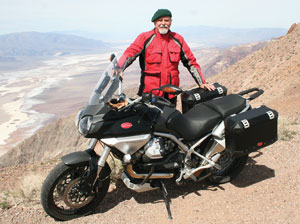
The best roads in this country are the ones with little or no traffic—at least to my way of thinking. I love tearing along the back roads, even if the asphalt is a bit broken and bumpy, with no traffic in sight, a few cows and horses looking up to see me whiz by. And puttering along more than a few miles of good dirt road, sheltered by trees, the occasional rickety bridge and decrepit barn, always makes my heart sing. Not that my heart can carry a tune or anything, but you get the idea.
This big adventure-oriented motorcycle from Moto Guzzi is an ideal mount for back roads, good dirt roads and even highways. It is comfortable and fast, with good brakes and handling, and pleasantly long suspension travel to soak up the imperfections in the roads. Sort of like the recent SUV and Crossover automobile craze, a perfect product for the nation’s crumbling infrastructure—and I’m talking about roads and bridges here. I know riders with tricked-out sportbikes who complain that they can find no smooth roads to ride on, other than the boring highways, while the beauty of the Stelvio is that it provides a good ride under all conditions.
The Stelvio remains your essential Moto Guzzi, with the 90-degree V-twin laid athwart the cradle frame, shaft drive to the rear wheel, just like the folks at the factory in Mandello del Lario have been turning them out for the past 40 and more years. The Guzzi, any Guzzi, is not a subtle machine, not one of those interchangeable “Gee, what am I riding?” motorcycles. It has a feel about it that anyone can easily identify, especially the vibrating thrum of the engine, which many come to love but others will find difficult to live with.
One of the primary considerations of the engineers was rider comfort. It is one thing to be crouched behind a racy fairing at 140 mph for brief periods, quite another to spend the day whisking through the corners, surrounded by beautiful mountain scenery, significant other sitting on the back. To this end, or we could say, to the riders’ ends, the seats are quite comfy, and rider ergonomics are good for many hours in the saddle.
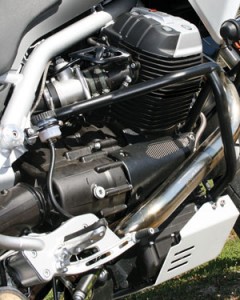
The Stelvio is an excellent example of why we motorcyclists love motorcycles—because they are fun. Just downright fun. Riders can have fun on sportbikes, on touring bikes, on single-cylinder dual-purpose bikes—two wheels and a motor, and we have fun. The Stelvio falls into the “adventure bike” category, big motorcycles, comfortable, can carry a lot, are generally unfazed by the condition of the road, but they do like roads, as they tend to be a bit too heavy for dirt single-tracks and cross-country work.
A cursory appreciation of the Stelvio shows that it is really intended for pavement use—as in the fabled Stelvio Pass with more than 80 hairpins from which this motorcycle derives its name, about a hundred miles northeast of Mandello. Yes, this is the prime focus of such a motorcycle—handling small, paved, very twisty roads with a lot more aplomb than can a sportbike. The Stelvio has wide bars, almost 36 inches across, making it easy to turn, with a rake of 27 degrees, trail of 4.9 inches. Even with a wheelbase of more than 60 inches it can cut a downhill hairpin with ease.
Three things give away the street orientation of the Stelvio, the first being its 600-plus-pound wet weight. Another is the engine, which is Guzzi’s sporty four-valve version that spins most happily at higher rpm. The two-valver is slightly torquier, better at plodding through the rough and tough, but this is intended for tearing along the byways. The third clue is the rather benign Pirelli Scorpion Sync tires, which provide excellent grip on the asphalt but lack the rugged tread pattern one needs for going through places like sand washes and mud holes. I should note that there is a TT version (Tutto Terreno—All Terrain) of the Stelvio that comes with honkin’ great knobbies, but its eventual availability here is uncertain.
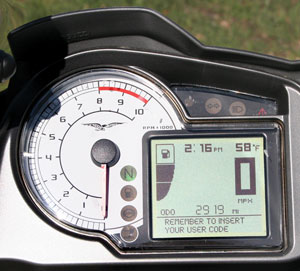
The motor is a slightly detuned version of the one found in the latest go-fast Griso model, displacing 1,151cc (oversquare 95mm bore, 81.2mm stroke), and advertising 103 crankshaft horsepower at 7,500 rpm. On the Jett Tuning Dynojet dyno our Stelvio test bike barked out 91.5 horsepower at 7,300 rpm and 69.4 lb-ft of torque at 6,500. The trick bits are the high camshafts, one in each cylinder, spun by Morse-type chains, with minimalist pushrods operating the four valves in each head. In best Guzzi fashion the tappet adjustments are done by threaded screws. The chain has a hydraulic tensioner which requires no maintenance.
The Weber-Marelli fuel injection uses 50mm throttle bodies, with a squish factor in the cylinders of 11 to one, which returned fuel economy of about 37 mpg for the 1,500 miles I covered—with admittedly cheerful use of the throttle. The tank is rated at 4.8 gallons, but it can be difficult to fill to the brim as the flip-up gas cap and the high-pressure California hoses with the vapor-reclaiming nozzles prevented me from topping off. The digital gas gauge has three sections, each winking out as the level drops, and the warning light comes on about 20 miles into the last third—and that warning-light range is good for more than 50 miles, as I stuck a container of gas in a saddlebag and ran it out at 53 miles one day.
Turn the key, push the starter, and you definitely know that there are a lot of parts moving around inside that engine. It’s not a quiet motor, but that all goes away as soon as you snick the shift lever into first and let out the clutch. It’s a single-plate automotivelike clutch, hydraulically operated, with adjustability at the lever to suit the hand, and does require a strong pull. Of the half a dozen gears to choose from, first gear takes you to over 55 mph before the rev-limiter cuts in at 8,000 rpm, while sixth is definitely an overdrive. It’s not an exceptionally smooth transmission, no hot knife through cold butter sort of thing, but the shifts are accurate. The final drive is via a shaft inside the single-sided swingarm, utilizing Guzzi’s much ballyhooed Compact Reactive Shaft Drive, or CA.R.C., as is written on the rear hub. The bugaboo from the old shaft drives, of abrupt inputs into the rear suspension due to final drive torque reactions, is pretty much a relic of the past.
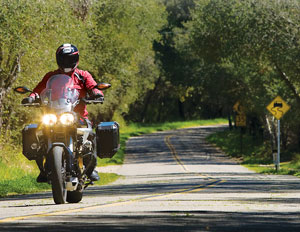
Now to the chassis, specifically designed for the Stelvio. The twin-spar tubular frame has thick steel tubing, with a pair of arms going down from the steering head to the front of the engine, two more mounts at the top, and two at the bottom back—six bolts in all. No twisting should take place with this frame and engine integration. The fork is an upside-down Marzocchi with 50mm tubes, fully adjustable, with 6.7 inches of travel and a leading axle. At the back a single Boge shock has preload and rebound damping adjustment—with an accessible knob for adjusting the preload. I like the fact that it is convenient to alter the suspension both fore and aft, not a chore at all.
The wheels use Behr rims and Alpina spokes, for those into such detail, and run tubeless Pirelli Scorpion Sync tires. Tubeless is not unusual for a wheel which has the spokes splayed to the edges of the rim, but these are straight spokes, running to the rim’s center, and each of the 40 spokes has a little seal inside. The concept works, but I wonder about the possibility of a leak, and any sealant would spin to the outside of the tire, not the inside of the rim. I suppose nervous folk susceptible to planumrotundumphobia (fear of flats) could put a tube in if they wished. The tires, a 110/80-19 front, 180/55-17 rear, are good and grippy, great for flogging the Stelvio through the tight and twisty, but do wear somewhat rapidly. Extreme angles can get the centerstand tips to touch, but not without really trying.
The Brembo brakes are well suited to the Stelvio’s disposition, as slowing down on a dirt road requires a sensitivity that some sportbike brakes lack. ABS is available, but this test unit did not have it. Up front is a pair of 320mm discs, fully drilled for enhanced heat dissipation, and a healthy squeeze to the radially mounted calipers holding four opposed pistons slow the bike down quite quickly. At the back a single 282mm disc has a caliper with two parallel pistons. Stainless-steel braided brake lines serve to enhance the feel and the feedback.
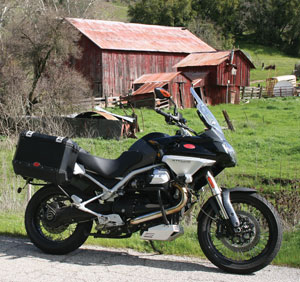 I’m an all-weather, all-road kind of rider, and the Stelvio suited me fine. The tallish 33.1-inch saddle height is standard for this kind of bike (think Buell Ulysses, KTM 990 Adventure, BMW R1200GS) and one soon learns what to throw a leg over the saddle really means. There is a lower position, taking it down the better part of an inch. The windscreen is manually adjustable, and very easy to do; we don’t need no stinkin’ electric motors. A small useful compartment is built into the right side of the gas tank, and to hinder thieves this can only be opened when the ignition is on. The sidestand is easy to deploy, something Guzzis have not always been noted for, but the centerstand pivot appears to be a bit off the ideal positioning, as the bike requires a real heave-ho to get it up.
I’m an all-weather, all-road kind of rider, and the Stelvio suited me fine. The tallish 33.1-inch saddle height is standard for this kind of bike (think Buell Ulysses, KTM 990 Adventure, BMW R1200GS) and one soon learns what to throw a leg over the saddle really means. There is a lower position, taking it down the better part of an inch. The windscreen is manually adjustable, and very easy to do; we don’t need no stinkin’ electric motors. A small useful compartment is built into the right side of the gas tank, and to hinder thieves this can only be opened when the ignition is on. The sidestand is easy to deploy, something Guzzis have not always been noted for, but the centerstand pivot appears to be a bit off the ideal positioning, as the bike requires a real heave-ho to get it up.
Since I was taking the bike from the coast over the Sierra Nevada Mountains to Death Valley, and back, we asked for a set of saddlebags, and got the rugged-looking Guzzi aluminum panniers you see here, which cost $1,000. Oddly enough they do not use the bike’s built-in mounts, but a tubular-steel bolt-on arrangement. The bags add 10 pounds apiece to our bike’s wet weight figure (mounts not included) and make the Stelvio wide, more than 42 inches, so I had to temper my California-legal lane-splitting tendencies. The lids have strap holders built in, useful for carrying bulky items like sleeping bags. Two complaints: First, you must use the key to open and close these lids, which I find a hassle. Second, there are no carrying handles, so when you take a bag off you have to heft it in both arms and take it wherever, and then go back and get the other one.
Further contributing to the Stelvio’s as-tested weight was the optional fog-light kit at $525. Obviously not trusting me, Guzzi also mounted a $350 engine guard (crashbars to you old-schoolers) and a small $150 guard to protect the rear hub should I fall over on a pile of rocks. As well as a beefed-up aluminum skid plate ($350) to protect the rather exposed oil pan from stray rocks.
I like the Stelvio, like riding the tightest, twistiest roads I can find, like the occasional excursion off the pavement and onto dirt roads, like wicking it up to triple digits on a deserted desert highway, well-protected behind the windshield. I like it in traffic, as I’m sitting up high and can with ease see around and/or through the vehicles in front of me. It’s not going to score high points from those addicted to excessive speed, nor those who like to ride the superslab, but an all-around rider will enjoy it.
Many Guzzi dealers are promoting their product by allowing test rides—do show up on your own bike when requesting one, as it makes the dealer feel a lot more secure. Ride the Stelvio, evaluate it for yourself. If you like it, cash in the kids’ college fund and go buy one. Tell the children that the military academies are free, with a guaranteed job upon graduation.
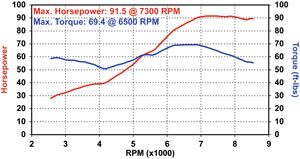
2009 Moto Guzzi Stelvio 1200 4V Specifications
Base Price: $14,990
Price as Tested: $17,365 (Engine guards, final drive guard, fog lights, side cases, skid plate)
Warranty: 2 yrs., unltd. miles
Website: www.motoguzzi-us.com
Engine
Type: Air-cooled, longitudinal 90-degree V-twin
Displacement: 1,151cc
Bore x Stroke: 95.0 x 81.2mm
Compression Ratio: 11.0:1
Valve Train: High cam, 4 valves per cyl.
Valve Adj. Interval: 930, then every 6,250 miles
Fuel Delivery: Weber-Marelli EFI w/ 50mm throttle bodies x 2
Lubrication System: Wet sump, 3.7-qt. cap.
Transmission: 6-speed, hydraulically actuated dry clutch
Final Drive: Shaft, 1:3.66
Electrical
Ignition: Electronic
Charging Output: 550 watts max.
Battery: 12V 18AH
Chassis
Frame: Twin-spar tubular-steel w/ engine as stressed member & single-sided cast-aluminum swingarm
Wheelbase: 60.4 in.
Rake/Trail: 27 degrees/4.9 in.
Seat Height: 32.1/33.1 in.
Suspension, Front: 50mm male slider, fully adj. w/ 6.7-in. travel
Rear: Single linked shock, adj. for spring preload (remotely) & rebound damping
w/ 6.1-in. travel
Brakes, Front: Dual floating discs
w/ radial-mounted opposed 4-piston calipers
Rear: Single disc w/ pin-slide 2-piston caliper
Wheels, Front: Sealed spoked steel, 2.5 x 19 in.
Rear: Sealed spoked steel, 5.5 x 17 in.
Tires, Front: 110/80-R19
Rear: 180/55-R17
Wet Weight: 648 lbs. (as tested)
Load Capacity: 399 lbs. (as tested)
GVWR: 1,047 lbs.
Performance
Fuel Capacity: 4.8 gals., warning light on last 1.2 gals.
MPG: 90 octane required (high/avg/low) 37.0/36.7/33
Estimated Range: 176 miles
Indicated rpm at 60 mph: 3,600









Love the Engine torque twist at idle truly an engineers Dream machine
I Love Those Motors!
I own this same bike and love it. Have an aux gas tank for additional range. Engine is sublime and addictive.